Recent experience by a Hampshire group funded by HAT has highlighted the importance of preserving the humble postcard. In attics, cupboards, garages and other places where hoarders store their treasures are thousands of them, many dating from the turn of the last century. Occasionally they surface and get snapped up in sales. Often they get jettisoned with all the other ‘old rubbish’.
It is this random fate that sharpens the appetites of collectors, who are often prepared to pay high prices for postcards that will embellish their collections, which may focus on quite narrow subject areas.
Equally interested in old postcards are local historians, for whom certain scenes have only ever been captured by chance decisions of photographers more than a century ago. Subtle changes to buildings, the heights of trees, the first appearance of telephone poles – all these tiny clues help to date photographs and to add to local knowledge.
From time to time these two interests collide, as happened recently with the Fleet and Crookham Local History Group , when a valuable local collection went under the hammer. This had been the life’s work of local author and former member, Percy Vickery, who died in January 2018. Fortunately, the purchaser agreed to sell on a large number to the group, thereby saving part of the collection.
Fourteen albums containing some 1,500 postcards might have disappeared and been dispersed had it not been for the work of the group’s Chair, Mrs Phyl Ralton. She contacted HAT, which was able to make a grant of £1,500, as part of the more than £19,000 recently awarded to six different projects in the county. She said: ‘We now have the job of sorting, scanning and cataloguing all this, so that the material will be held in our group archive or the Hampshire Record Office and made available to enquirers.’
The collection includes views of Fleet Pond in all seasons, the Basingstoke Canal, local roads when they were still tree-lined and unmade, and churches some of which no longer exist. There are also a variety of events, such as carnivals, fires, road and rail accidents. Local shops and businesses with their proud owners, now long gone, are also well represented.
The picture postcard first got underway in France in 1870, though the British Post Office in the same year authorised a blank card with a printed stamp. It was 1894 before permission was given to use printed postcards, first pioneered in this country by the firm of ETW Dennis of Scarborough. In 1902, Britain led the way with the ‘divided back’ card, with separate spaces for the address and greeting.
This was followed by a ‘golden age’, as hundreds of photographers produced picture postcards of local scenes. Often people could post pictures of their own street – and get it delivered the same day!
There is no shortage of material in the archives: The Hampshire Record Office has more than 6,000 postcards listed in its online catalogue. And enthusiastic collectors are catered for by the Postcard Traders Association and Picture Postcard Monthly, published in Portsmouth.
Editor, Mark Wingham, said: ‘Collecting postcards remains an extremely popular hobby, but one which is undergoing change. Every weekend across the country, dedicated postcard fairs are being held – but the number of both dealers and collectors who attend them is declining in some areas, as many of the people who use fairs as their traditional way of buying tend to be older.
‘New collectors are entering the hobby both via online auctions and because of an initial interest in family history, which is drawing them into developing wider interests in postcards. And the auction scene is lively, with postcards remaining high in demand. Whilst coins and stamps were mass produced, there are not many hobbies like collecting postcards where sometimes unique items, which are more than a century old, can be bought so cheaply.’




